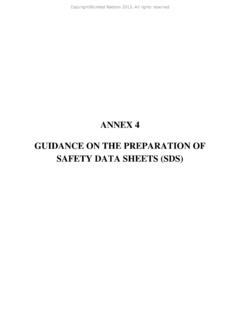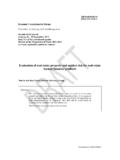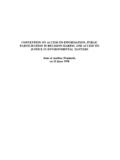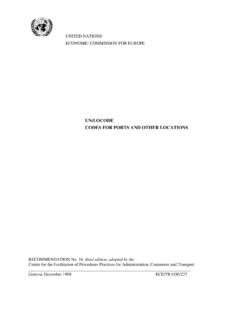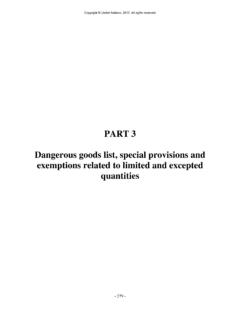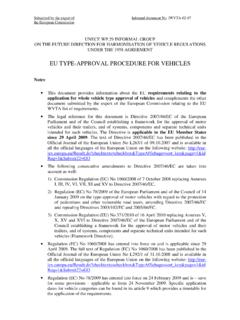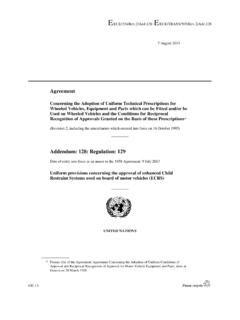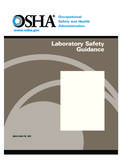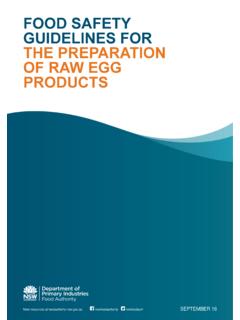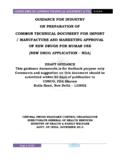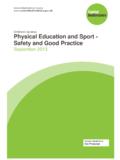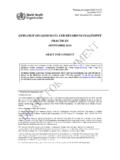Transcription of ANNEX 4 GUIDANCE ON THE PREPARATION OF …
1 Copyright@United Nations, 2009. All rights reserved. ANNEX 4. GUIDANCE ON THE PREPARATION OF. safety data SHEETS (SDS). - 403 - Copyright@United Nations, 2009. All rights reserved. Copyright@United Nations, 2009. All rights reserved. ANNEX 4. GUIDANCE ON THE PREPARATION OF. safety data SHEETS (SDS). Introduction This ANNEX provides GUIDANCE on the PREPARATION of an SDS under the requirements of the Globally Harmonized System of Classification and Labelling of Chemicals (GHS). SDS's are an important element of hazard communication in the GHS, as explained in Chapter Use of this GUIDANCE document should support compliance with competent authority (CA) requirements and should allow the SDS to be prepared in accordance with the GHS. The use of this GUIDANCE document is dependent on importing countries requirements for SDS. It is hoped that the application of the GHS worldwide will eventually lead to a fully harmonized situation.
2 Unless otherwise stated, all chapters, sections and tables referred to in this ANNEX can be found in the main text of the GHS. General GUIDANCE for compiling an SDS. Scope and application safety data Sheets (SDS) should be produced for all substances and mixtures which meet the harmonized criteria for physical, health or environmental hazards under the GHS and for all mixtures which contain ingredients that meet the criteria for carcinogenic, toxic to reproduction or target organ toxicity in concentrations exceeding the cut-off limits for SDS specified by the criteria for mixtures (see Table in Chapter ). The competent authority (CA) may also require SDS for mixtures not meeting the criteria for classification as hazardous but which contain hazardous ingredients in certain concentrations (see Chapter ). The CA may also require SDS for substances or mixtures that meet the criteria for classification as hazardous for non-GHS classes/end-points.
3 An SDS is a well-accepted and effective method for the provision of information, and may be used to convey information for substances or mixtures that do not meet or are not included in the GHS classification criteria. General GUIDANCE The writer of the SDS needs to keep in mind that an SDS must inform its audience of the hazards of a substance or a mixture and provide information on the safe storage, handling and disposal of the substance or a mixture. An SDS contains information on the potential health effects of exposure and how to work safely with the substance or mixture. It also contains hazard information derived from physicochemical properties or environmental effects, on the use, storage, handling and emergency response measures related to that substance or mixture. The purpose of this GUIDANCE is to ensure consistency and accuracy in the content of each of the mandatory headings required under GHS, so that the resulting safety data sheets will enable users to take the necessary measures relating to protection of health and safety at the workplace, and the protection of the environment.
4 The information in the SDS shall be written in a clear and concise manner. The SDS shall be prepared by a competent person who shall take into account the specific needs of the user audience, as far as it is known. Persons placing substances and mixtures on the market shall ensure that refresher courses and training on the PREPARATION of SDS be regularly attended by the competent persons. When writing the SDS, information should be presented in a consistent and complete form, with the workplace audience firmly in mind. However, it should be considered that all or part of the SDS can be used to inform workers, employers, health and safety professionals, emergency personnel, relevant government agencies, as well as members of the community. - 405 - Copyright@United Nations, 2009. All rights reserved. Language used in the SDS should be simple, clear and precise, avoiding jargon, acronyms and abbreviations.
5 Vague and misleading expressions should not be used. Phrases such as may be dangerous , no health effects , safe under most conditions of use , or harmless are also not recommended. It may be that information on certain properties is of no significance or that it is technically impossible to provide; if so, the reasons for this must be clearly stated under each heading. If it is stated that a particular hazard does not exist, the safety data sheet should clearly differentiate between cases where no information is available to the classifier, and cases where negative test results are available. The date of issue of the SDS should be stated and be very apparent. The date of issue is the date the SDS version was made public. This generally occurs shortly after the SDS authoring and publishing process is completed. Revised SDS's should clearly state the date of issue as well as a version number, revision number, supersedes date or some other indication of what version is replaced.
6 SDS format The information in the SDS should be presented using the following 16 headings in the order given below (see also ): 1. Identification;. 2. Hazard identification;. 3. Composition/information on ingredients;. 4. First-aid measures;. 5. Fire-fighting measures;. 6. Accidental release measures;. 7. Handling and storage;. 8. Exposure controls/personal protection;. 9. Physical and chemical properties;. 10. Stability and reactivity;. 11. Toxicological information;. 12. Ecological information;. 13. Disposal considerations;. 14. Transport information;. 15. Regulatory information;. 16. Other information An SDS is not a fixed length document. The length of the SDS should be commensurate with the hazard of the material and the information available. All pages of an SDS should be numbered and some indication of the end of the SDS should be given (for example: page 1 of 3 ).
7 Alternatively, number each page and indicate whether there is a page following ( Continued on next page or End of SDS ). SDS content General information on SDS content can be found in More practical information is given below. The minimum information outlined in section of this ANNEX should be included on the SDS, where applicable and available1, under the relevant headings. When information is not available or lacking this should be clearly stated. The SDS should not contain any blanks. In addition, the SDS should contain a brief summary/conclusion of the data given, making it easy even for non-experts in the field to identify all the hazards for the hazardous substance/mixture. 1. Where applicable means where the information is applicable to the specific product covered by the SDS. Where available means where the information is available to the supplier or other entity that is preparing the SDS.
8 - 406 - Copyright@United Nations, 2009. All rights reserved. Use of abbreviations is not recommended because they may lead to confusion or decreased understanding. Other information requirements There are information requirements for the PREPARATION of an SDS. The minimum information requirements are outlined in In addition to the minimum information requirements (see ), the SDS may also contain additional information . Where a material has additional relevant and available information about its nature and/or use, that information should be included in the SDS (see for further advice on additional information requirements). Units Numbers and quantities should be expressed in units appropriate to the region into which the product is being supplied. In general, the International System of Units (SI) should be used. Information requirements for the PREPARATION of the SDS.
9 This section describes the GHS information requirements for SDS's. Additional information may be required by competent authorities. SECTION 1: Identification Identify the substance or mixture and provide the name of the supplier, recommended uses and the contact detail information of the supplier including an emergency contact in this section. GHS Product identifier The identity of the substance or mixture (GHS product identifier) should be exactly as found on the label. If one generic SDS is used to cover several minor variants of a substance or mixture, all names and variants should be listed on the SDS or the SDS should clearly delineate the range of substances included. Other means of identification In addition, or as an alternative, to the GHS product identifier, the substance or mixture may be identified by alternative names, numbers, company product codes, or other unique identifiers.
10 Provide other names or synonyms by which the substance or mixture is labelled or commonly known, if applicable. Recommended use of the chemical and restrictions on use Provide the recommended or intended use of the substance or mixture, including a brief description of what it actually does, flame retardant, anti-oxidant, etc. Restrictions on use should, as far as possible, be stated including non-statutory recommendations by the supplier. Supplier's details The name, full address and phone number(s) of the supplier should be included on the SDS. Emergency phone number References to emergency information services should be included in all SDS. If any restrictions apply, such as hours of operation ( Monday - Friday, 8:00 - 6:00 , or 24 hours) or limits on specific types of information ( , medical emergencies, or transportation emergencies), this should be clearly stated.
